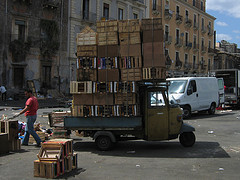
- Be careful with those sharp curves
In Italy, shopkeepers still hope to sell you a Betamax at a profit
One of the most surreal sights I’ve seen in Italy was a girl feeding a boy lasagna with a fork from the back of the Vespa he was driving. Yet weird Vespa experiences are not all that unusual here: I’ve seen a three wheeled Vespa pickup (the in-famous Ape) flip over at an intersection under the weight of a load of boxes piled more than three times its height. Yesterday I followed a red Vespa through crowded cobblestone streets, amazed at the driver’s ability to control his scooter while carrying a large gate for a picket fence. Alas, the suicidal maneuvers of helmetless teenagers upon speeding two wheelers have long lost their novelty value.
Another surreal but common sight in Italy is the obsolete product at an absurd price in the front window of a Mom and Pop shop. The absurdity comes not just from the fact that the shopkeepers continue to proudly display a slide projector to passersby, as in the case of a photo shop I marvel at every morning, but that they persist in attaching a widely optimistic price tag to something which by now has little, if any, value. Indeed, unable to shift traditional cameras in the wake of the digital revolution, photo shops are a prime example of this extortionate optimism. The hope seems to be that some gullible antiquarian will pop in and make up for their years of patience.
 I had a keen insight into to the logic of the Italian shopkeeper upon visiting a negozio di casalinghi(housewares store) which was filled with decades old products. My wife, an enthusiast of Italian designer housewares like Alessi and Guzzini, was stunned to see products she remembered from her childhood. “It looks like a museum of the 1980s”, she whispered as she picked up a faded box containing an old Guzzini breadbox, “my mother threw this away years ago”. The products were so old that none of them were made in China. The toy section was even more historic. As a Canadian I was amazed to see a ye olde knockoff tabletop hockey game in the Italian provinces. If it had been a Coleco model, rather than an unknown brand, I might have even paid the €30 price. For girls, the selection was even better, they had a complete set of louche Barbie furniture from the late 70s and an aged Barbie Ferrari for only around €30. The box of the car was battered and it was clear the price had been “adjusted” several times. If it had cost €30 (60,000 lire) in 1980, the price would have amounted to about a fifth of the average monthly wage. The owner’s prompt refusal of our request for a discount as we left confirmed our hypothesis. “These are classic products”, she said, “we do not know their real value anymore”.
I had a keen insight into to the logic of the Italian shopkeeper upon visiting a negozio di casalinghi(housewares store) which was filled with decades old products. My wife, an enthusiast of Italian designer housewares like Alessi and Guzzini, was stunned to see products she remembered from her childhood. “It looks like a museum of the 1980s”, she whispered as she picked up a faded box containing an old Guzzini breadbox, “my mother threw this away years ago”. The products were so old that none of them were made in China. The toy section was even more historic. As a Canadian I was amazed to see a ye olde knockoff tabletop hockey game in the Italian provinces. If it had been a Coleco model, rather than an unknown brand, I might have even paid the €30 price. For girls, the selection was even better, they had a complete set of louche Barbie furniture from the late 70s and an aged Barbie Ferrari for only around €30. The box of the car was battered and it was clear the price had been “adjusted” several times. If it had cost €30 (60,000 lire) in 1980, the price would have amounted to about a fifth of the average monthly wage. The owner’s prompt refusal of our request for a discount as we left confirmed our hypothesis. “These are classic products”, she said, “we do not know their real value anymore”.

- Solo €950!
The concept of opportunity cost does not seem to guide Italian shopkeepers, who prefer to adjust the prices of aging merchandise for inflation rather than reduce their losses by moving it out. My all time favourite example is the electronics store that filled its display window with a collection of first generation video recorders priced to stay there for another 25 years. It looked like a joke: a stack of historic VCRs like the Sony Betamax for prices close to €1,000! Sure they may have cost that in the 1970s, as early adopters paid a premium to get the latest technology, but it seems unrealistic to maintain such prices in the new millennium. The VCR history remained in the window for about a year – I like to think a collector found his treasure trove and, in the process, allowed the shop to bring in new products like the Commodore 64 personal computer.






Latest Comments